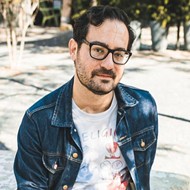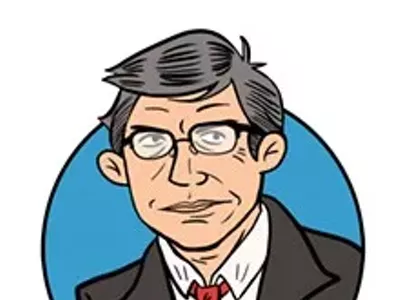Though her days of fronting the influential punk band Destroy All Monsters are largely behind her, Niagara just can't seem to escape the spotlight. Despite her best efforts at reclusiveness — Niagara and her husband, a man known as the Colonel, are getting ready to move away from the city — Niagara's had a busy last couple of years. She collaborated with Kate Moss for British Vogue; had her artwork hand-picked by Kid Rock for his latest album cover; and the Spanish label Munster Records recently released a Destroy All Monsters box set, Hot Box 1974-1994. We heard through the grapevine that Niagara wasn't pleased with our coverage of the box set, so we called her up to shoot the shit.
Metro Times: What are you up to right now, Niagara?
Niagara: I'm going to be moving within the year. I'm just moving where there are no neighbors — which is like a dream come true. Can you imagine, no neighbors? I think change is all we need. You start to die unless you change. Sorry, I'm starting to talk about death already. So, why are you doing this?
MT: Um, we heard you didn't like our interview with Cary Loren about the new Destroy All Monsters box set .
Niagara: He didn't have anything to do with putting out this record. But he did email me to say don't put it out. He tried to stop it, that's all he had to do with it.
Good music editor, though. I mean, that was novel! You get famous for doing novel approaches and maybe it was just a new approach.
I had nothing to do with putting this album together, but they put together a pretty nice booklet of artwork and diaries and things that I had put out. Colonel put it together with them. I wasn't paying attention at all to what they put together.
MT: Colonel handles all of that stuff?
Niagara: Yeah, otherwise it would never get done. I did my part — I worked really hard when I look back, I did more than my share!
MT: What else is new? I had this really weird experience of driving down Woodward the other day and I saw a billboard with your artwork for the new Kid Rock record, First Kiss, not far from the old CPop Gallery, where you used to show your work.
Niagara: That's pretty funny. It's funny seeing Jimmy Fallon holding it. All sorts of fans are using that image for all sorts of other things, like pasties for your tits. And I thought, "God, that's pretty cool." And all the Facebook people are like, "Go get 'em, go after them!" I'm like, "Are you kidding?" I have better things to do. It's not worth it. I think it's cute.
MT: That was an early painting, right?
Niagara: More than 15 years ago, I think. I was friends with someone who worked for the Metro Times, Thom Jurek, who wrote for the arts. He saw the image and said it was iconic — he got it right away. But people don't get art right away usually. If something is iconic and you can tell right away like he could, it takes years to sink in. Especially if the artist dies — then you can really like it. It's so easy to love someone when they're dead.
You know, Kid Rock also had me paint his portrait.
MT: Was this recently? Was he already familiar with your work?
Niagara: It was recently, but I remember back when CPop was in Royal Oak first he was at a show, just as he was beginning to get famous, I guess. And people were going "Oh, Kid Rock is here." And I was like, "Who? What? Where?" But he was coming to shows, and then he saw that painting and figured it would go good with the title of his album and that he could help put out this book about that Orbit anthology. So that was nice of him to do that. And then he thought he would have me do his portrait.
MT: Another thing that came up recently was the Kate Moss photo fashion shoot. How'd that project come about?
Niagara: Vogue called, and said, "Our editor simply loves you and wants to do something. Send us some pictures of you and art." So Colonel did that and I forgot about it, as usual, because we get those requests pretty often. After a few months we find out that the editor was a guest editor, and it was Kate Moss. She got a model that they tried to make look like me, and it was amazing. I sent her a thank you for throwing me a bone. I've always wanted to be in Vogue. I sent her some T-shirts with my pictures on them, and they took a picture of her. That was kinda cute, too. I never heard from her and I didn't expect to, but I think that was more than enough that she wore the damn thing.
MT: So right now your main project is to move out into the wilderness where you will have no neighbors?
Niagara: Yeah. I only have to design a whole new exterior and interior. I shouldn't panic. I always panic until I take a pill that says "don't panic," and then I'm like, "This the greatest thing ever." Even moving into a house that's already ready is a big panic anyway, so this will be a lot more exciting. And then nobody can get to me ever again. The end.
MT: And Niagara lived happily ever after.
Niagara: We'll never hear from this chick again. And her art is starting to look good now!
MT: Are you mostly focused on visual art these days?
Niagara: Oh yeah. The last few months it's been in like three museums — and now that I say it, it's like, "So what?" It's like Andy Warhol said — "As soon as you stop wanting something you get it. I've found that to be absolutely axiomatic." And it's true. But in Detroit, you would never think of putting it in a museum. You have to be dead for a couple hundred years before they will consider it. Other cities are actually featuring art by people who have done it in the last 20 years.
MT: Right, I saw you were recently featured at the RISD Museum in Rhode Island.
Niagara: Yeah. Stuff we did when I was with Mike Kelley and Jim Shaw. We went to U of M and met and that stuff that we did, now they're calling it a "collective." At the time we didn't know we were a collective. In fact, we were just fighting about everything. That was our version of a collective. We had a lot of fun.
MT: Do you do a lot of commission work or mostly just you creating your own work?
Niagara: The last couple years have been a lot of commissions. I can’t complain about that. That was something that I would have begged for, I would have dreamed about, but sometimes you want to paint whatever. There used to be a Patti Smith vintage clothing store in Royal Oak that had a huge window display. My first show was my paintings in all of the windows — people were buying stuff out of the windows.
MT: Then there were the CPop years.
Niagara: I was thinking about CPop today. What a really amazing gallery that was. I went to an astrologer in the early ’90s and he said that Detroit’s going to become a center for the arts, the visual arts. And I was like, “Who are you kidding, buster?' And then it happened in the next couple years, and it was because I got together with Rick (Manore, of CPop).
MT: How do you know Rick?
Niagara: I was slightly aware of (CPop) and I was just looking for a gallery and I heard he was going to have Robert Williams come in town. They told Robert Williams about me, and I was featured in Juxtapoz before, so I thought, “Oh God I have to go to CPop and do that, but I hate standing in line and trying to meet someone famous. I can’t do it. I don’t know what to do, but I have to do it.” So I called up and Rick answered and I asked, “Is Robert Williams coming to town?” And Rick goes, “Is this Niagara? Because I want to show your work off!” He practically was all over it.
MT: So through art you met him.
Niagara: Rick was like, “You guys pick him up!” So that I could relate to. Standing in line to meet someone, I just can’t do it — but to pick him up at the airport, that was more like it. They came to town a couple times and stayed with us at our house. I talked to Robert recently and he’s so fun.
MT: Can you talk about your process for your paintings? They're paintings, but they look like screen prints — you even make the colors off-register.
Niagara: The more you know about art the more you think that they look printed. There have always been arguments about that. And if someone was an art teacher they go, "No, I can see it has been printed because it's off-register." That's the point. I kind of like that off-register look. It's so corny to put it in register. I couldn't do that.
You're the first person to ever interview me to have knowledge of any kind of procedure. I used to use the old-fashioned way where you do your original little sketch and then graph it out on a big version of the graph on the canvas. That was exhausting. Then I finally realized I could blow this up. I could actually sketch exactly what I want and blow it up! I have all these processes I have to go through, where I'll do this perfect sketch, a detailed sketch. Then I'll put a clear piece of paper over that and then I'll outline it, and then I'll project that, and then I'll color it in, and then I'll ink it in by looking at the original sketch. Now you can do it.
MT: "How to do a Niagara."
Niagara: You should try it. It's very deadly. It's amazing that I've survived this long. I'm sorry to say that almost everyone I've known has died of this or that. MC5 is dwindling, but Dennis Thompson's still kicking. Even if he dies, his corpse will be kicking because he is just a live wire anyway.
You see a lot of death when you're in the rock world anyway. You make more friends than usual, than necessary. I only just really wanted to paint. But I realized when I was younger, you can't have a young artist. I had nowhere to go. There was no gallery that would take me seriously. And I don't blame them. You can't walk in, like college age, and go, "I'm an artist — I'm an artiste in fact, here's some stuff that's bad." You have to be more tried and true and they want to see some maturing. I had to have some time-wasters for like 15 years before I could do that, so I ended up being in a band. I didn't just feel like I was wasting time — I was playing with Ron Asheton — but it seemed to work out pretty good.
MT: When did you last perform?
Niagara: I think it was in Australia. It was about a year or more after Ronnie died. I couldn't shake off the darkness, and I didn't want to go on tour because it's not all it's cracked up to be sometimes. But I just said yes because I needed something to jar me out of whatever I was in. And it did the trick. When you change everything it drives you out of it. That was a cool tour. The Australians are so nice and so supportive. They're so nice they make you crazy, so you yell at them. They have this expression: "No worries, mate." And then you have to shake them. "What do you mean, no worries? There's a lot of worries!" That was fun doing that tour and yelling at them, to make them have a Detroit attitude after a while.
MT: Do you see yourself performing again anytime soon?
Niagara: It'd have to be such amazingly wonderful circumstances. It's a lot of hassle. I keep forgetting the words, but nobody notices. You could say just gibberish and nobody would notice. But I like to remember. Moneywise, it's nothing compared to what I'm doing now. Hardly anybody cares about seeing me onstage. There's probably a fanatic in each country. One guy. There's always something that maybe I couldn't refuse, an offer. It's quite possible.
See Niagara's art at niagaradetroit.com.







